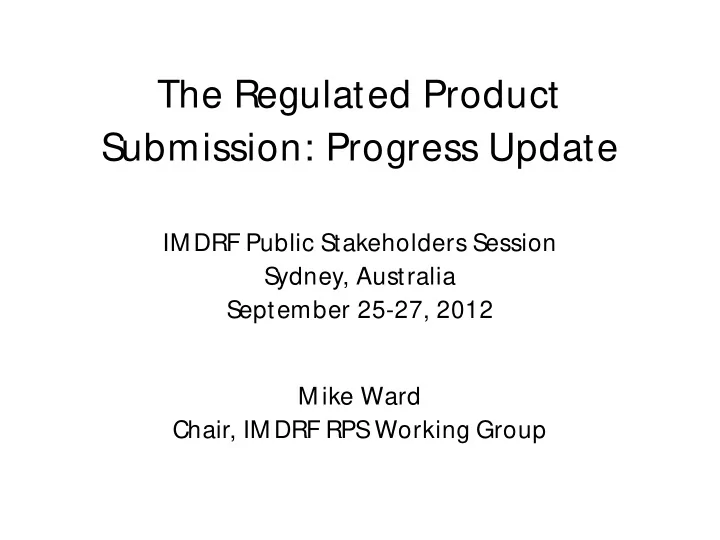

The Regulated Product Submission: Progress Update IM DRF Public Stakeholders Session S ydney, Australia September 25-27, 2012 M ike Ward Chair, IM DRF RPS Working Group
IM DRF RPS Proposal • Composed of two complementary components: – Beta testing of RPS Standard to confirm it is fit for purpose for medical devices – Develop common, modular Table of Content (T oC) for device applications (IVD and non-IVD) • Project takes account of existing work: – Beta testing: HL7 RPS WG and ICH – T oC: GHTF STED documents • Project seen as important step towards ultimate goal of common premarket requirements for device applications
The Regulated Product Submission (RPS) • RPS is a message standard that can be used for the electronic submission of product information between a company and a regulatory agency for the purpose of gaining market authorization • M essage standard (envelop) is independent of submission content (letter) • Scope: – M eant for worldwide use: same model for all product types, all regulatory agencies – Project charter includes pharmaceuticals, food additives and medical devices
Why is this important? • RPS will allow for unprecedented functionality in terms of the review and management of regulated product information over the entire product life cycle • Use by regulatory agencies across product lines provides for resource savings and greater efficiencies, including with respect to the training of reviewers • Expected to increase the efficiency and effectiveness of regulatory processes internationally
Sponsor Pre-Market Submission & Approval Database Correspondence or Submission from Approval from RPS provides standard Sponsor definitions and data Agency relationships to help sponsors and regulators RPS communicate about pre- market submissions Agency Pre-Market Submission & Approval Database 5
Health Level Seven (HL7) • Development of RPS being undertaken through HL7, an ANSI accredited Standards Development Organization (SDO) • Founded in 1987, now has 2,300+ members in over 34 countries • Develops standards to improve information sharing and interoperability between health care systems • M any HL7 standards are also ISO TC-215 standards • RPS one of several projects under the Regulated Clinical Research Information M anagement (RCRIM ) working group
Developing ISO Standards via HL7 ISO TC 215 HL7 M OU HL7 develops health informatics standards that can become ISO standards via two paths: – Joint Initiative: standards work is done in both organizations and goes to ballot in both groups simultaneously – Fast Track: an approved HL7 standard is balloted through ISO as a DIS 7
Approach • Focus efforts on potential differences in business requirements between drugs and devices • Establish minimum test package required for such testing • Doesn’t rely on common ToC: use existing application formats to test business requirements • Distinguish between what necessary for 1) testing and 2) eventual implementation
Progress to Date: Beta T esting • IM DRF RPS WG formed (regulators and industry from various countries/ regions represented by IM DRF) • Project plan developed • Series of teleconferences held to familiarize WG members with HL7/ RPS and gain agreement on approach/ plan • Participated in HL7 RPS teleconferences • First meeting held in Ottawa, September, 2012
Outcomes of Ottawa M eeting September 8-9, 2012 • Agreed on list of action items, overall test strategy and formation of 2 subgroups : – test strategy – implementation guides/controlled vocabularies • Identified possible test scenarios • Drafted invitation letter to software vendors • Discussed plans to implement RPS (Phase 2) and ‘interim’ options • Agreed that beta test group should serve as forum for broader information sharing related to eBusiness, such as gateways, eReview plans, etc. • Subsequent update to HL7 RPS WG at annual meeting in Baltimore (Sept. 11)
T oC Work Stream • Working towards a comprehensive, modular ToC that uses common language for each of the following submission types – Non-IVD M arket Authorization – IVD M arket Authorization – Non-IVD Clinical Trial Authorization – IVD Clinical Trial Authorization • M eeting in Ottawa included discussions to refine both non-IVD and IVD market authorization ToCs
Approach • Prior to the meeting, using HC ToC as baseline, jurisdictions worked to identify synonymous headings and missing headings • M eeting discussions involved understanding general content expected under each heading and discussion of granularity of ToCs • Issues & Challenges – Level of granularity (art not science) – Different regional regulatory languages
Outcomes of Ottawa M eeting • Refined both IVD and non-IVD ToC • Gained much better understanding of one another’s regulatory language • Developed more jurisdiction-neutral headings • Captured some high-level elements that fall within headings • Assigned modules to participating jurisdictions
Next Steps • Beta Test Stream: – Engage software vendors – Develop final test package – Conduct Beta testing (January – April 2013) – Submit Ballot comments (August 2013) in advance of Normative Ballot (September 2013)
Next Steps • ToC Work Stream: – Conduct review of T oCs against current requirements to ensure no gaps have been created – Work to more formally document general elements that belong under headings – Continue with refinement to headings and granularity
Acknowledgments • Karin Sailor, M edtronic • M ark Gray, CDER, US FDA • Brian Dowling, Health Canada
Questions?
Recommend
More recommend